Retail experts are in enthusiastic agreement, that the outlook is optimistic for Generative AI. Accenture’s Technology Vision 2023 research found that 96% of retail executives are saying they’re extremely inspired by the new capabilities offered by foundation models.
The scope for Generative AI to transform the retail value chain goes beyond forecasting and managing customer demand during major shopping seasons – although those are significant milestones in every organization’s retail calendar. Its real potential lies in tapping into generative capabilities reshaping the entire customer journey.
From sales records to customer preferences, retail brands are data goldmines. By fusing foundational language models with this wealth of information, retailers can harness Generative AI to craft personalized shopping experiences or improve business processes like never before:
- Customer support and assistants through improved LLM-based chatbots
- Intelligent search and summarization for inquiries and sales
- Consistent product descriptions generated through AI
- Synthetic inventory data generation to simulate supply chains
- Streamline the process of product development
- Label generation enhanced accuracy
- Personalized promotions through text and image generation
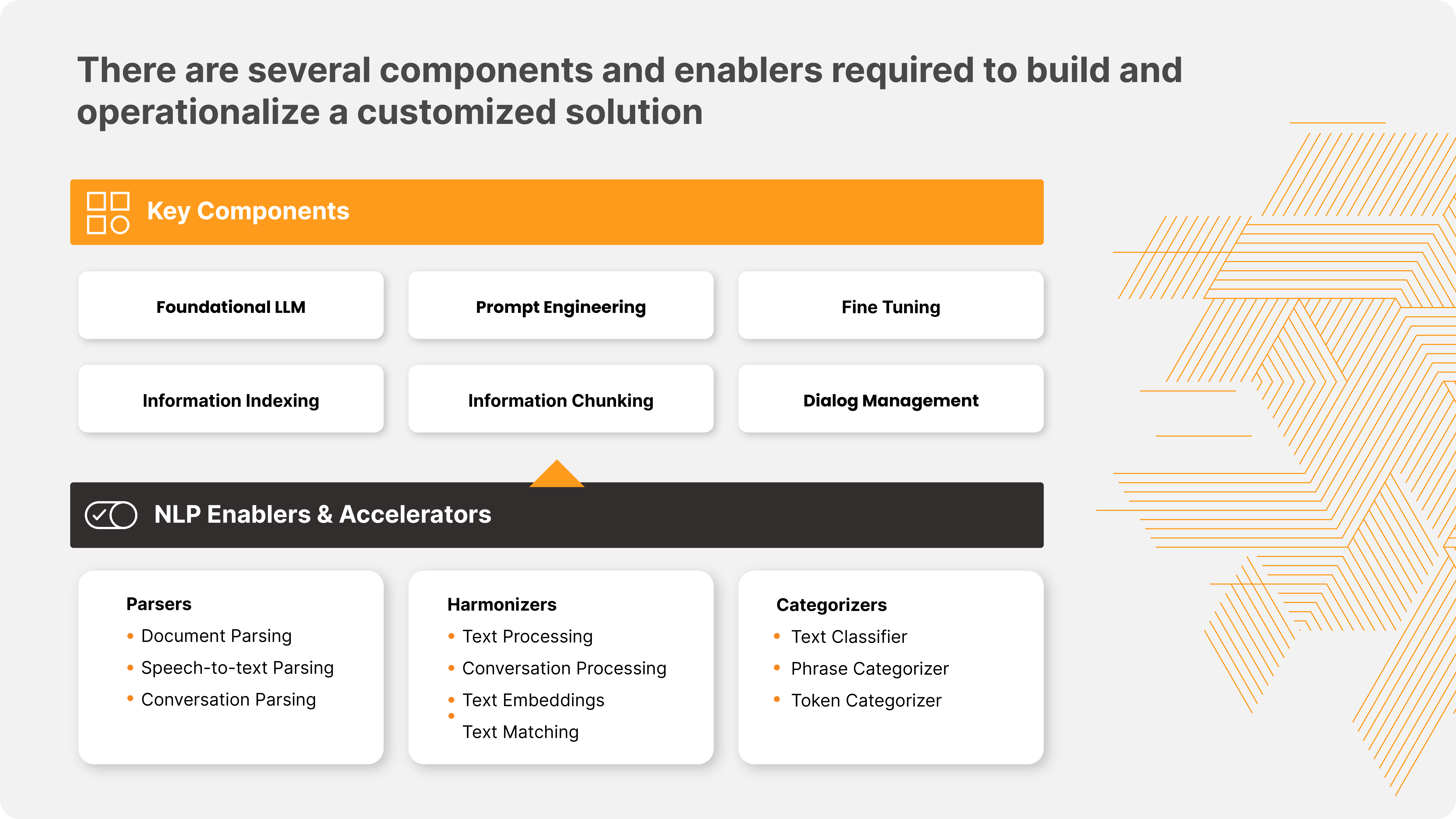
Building and operationalizing a bespoke solution using foundational AI models requires several components and enablers to be successful. Components for prompt engineering, dialog management, and information indexing are necessary to extract the best out of an LLM. When coupled with various NLP Accelerators such as document parsing, speech-to-text, and text embedding an end-to-end solution can be developed and deployed.
At Tiger Analytics, we’ve worked with various retail clients to elevate retail CX and work productivity and CRM with an AI/ML-driven customer data garden, streamlining and automating targeting models. Here are our observations
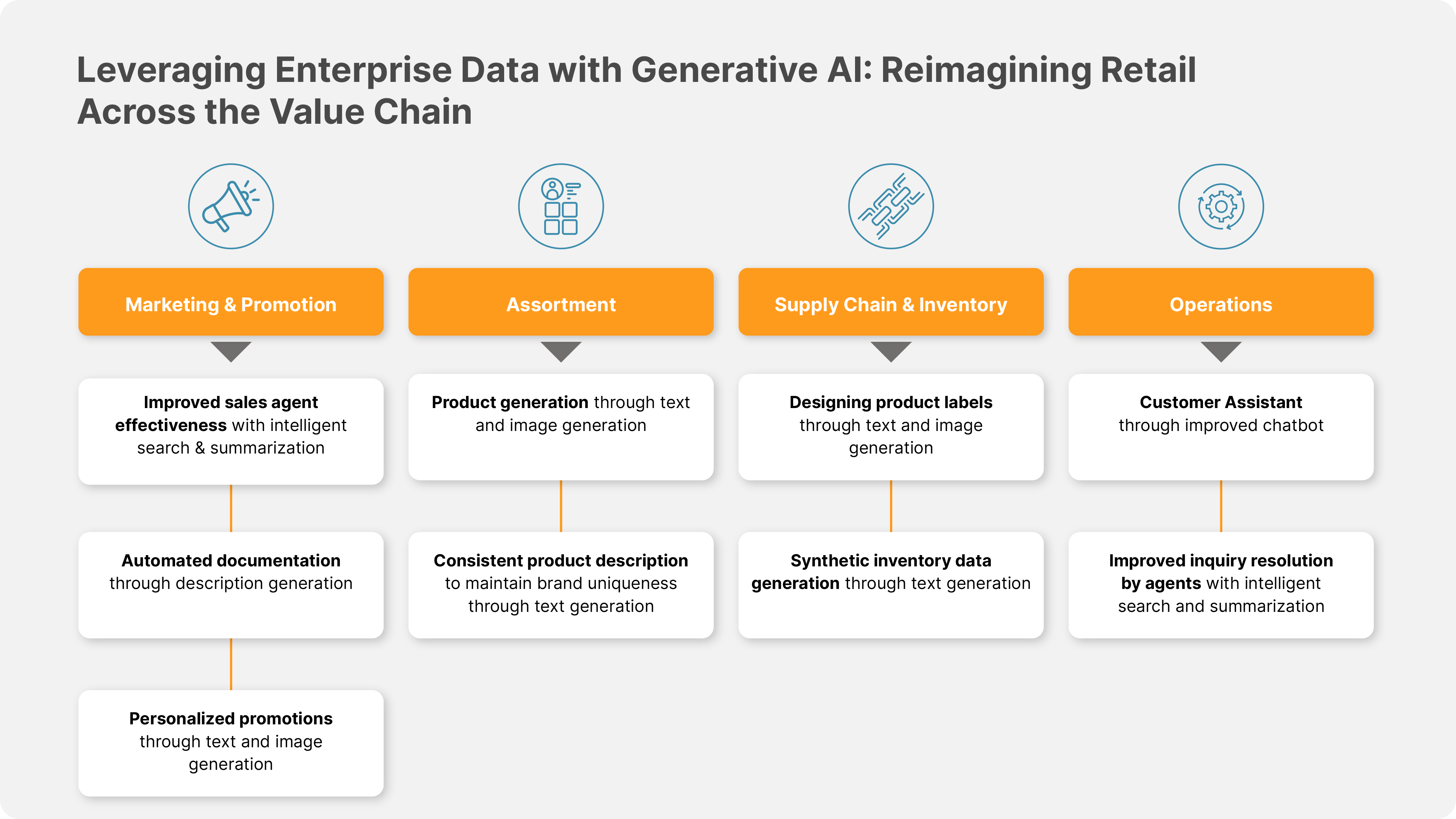
Streamlining Product Descriptions for Better Consistency and Cost Savings
Writing product descriptions for the entire catalog of products is a time-intensive and manual activity for most retailers. Add to this, the variations in consistency in terms of tone of writing style across different departments and countries make this a difficult problem to solve. Retailers need to ensure that the descriptions are relevant and concise to facilitate more conversions. They also need to keep the writing consistent across their e-commerce portals, campaigns, and digital content.
Generative AI can make this process smoother while being more cost-efficient. Customized LLMs can be trained to generate automated descriptions based on product attributes and specifications. Content can be standardized to the company’s style and tone for use across media. For retailers with an evolving product portfolio, this becomes a more scalable way to write and maintain product descriptions. Such a solution can be developed by fine-tuning a foundational LLM such as GPT, T5, or BART with annotated product data, product catalogs, and relevant SEO keywords. By incorporating human feedback, the descriptions can be further tailored to specific styles and needs.
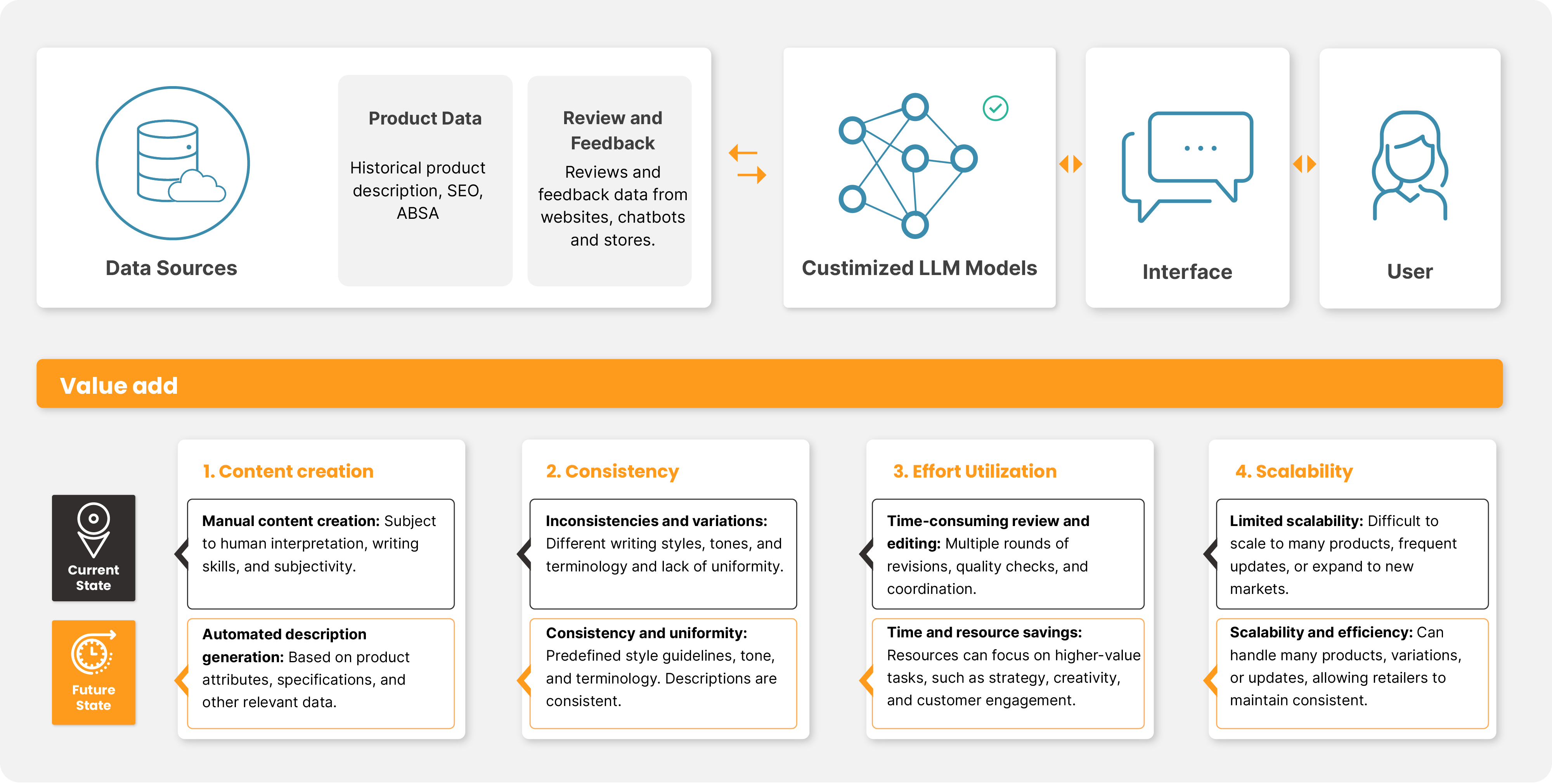
Illustration for Consistent Product Description Solution
Customer Support with Better Understanding and Efficiency
The biggest problem with chatbots before LLMs was that they could not converse in natural language. This led to frustrating experiences for users who would eventually give up on using the bot. As many of the bots in the past were not well-linked with human agents, it led to low customer satisfaction and churn.
LLMs are a perfect solution to this problem. Their strength lies in generating natural language conversational text. They are also good at summarizing vast amounts of text into concise and understandable content. To develop a customer assist solution that works, retailers can deploy LLMs in key parts of the process:
- Converting user speech to text
- Summarizing the user query
- Relaying summarized information to the user
- Helping support agents query large amounts of information and generate concise responses.
LLMs need to be used in conjunction with components such as dialog management and work on top of issues, orders, and product data to deliver contextual responses to user queries. Due to the advanced context retention capabilities of LLMs, conversations can naturally progress with continuity, allowing for in-depth dialogue over an extended interaction and the context of the user’s query can be inferred clearly. This enhances customer interaction dramatically and can make the entire support process both effective and cost-efficient.
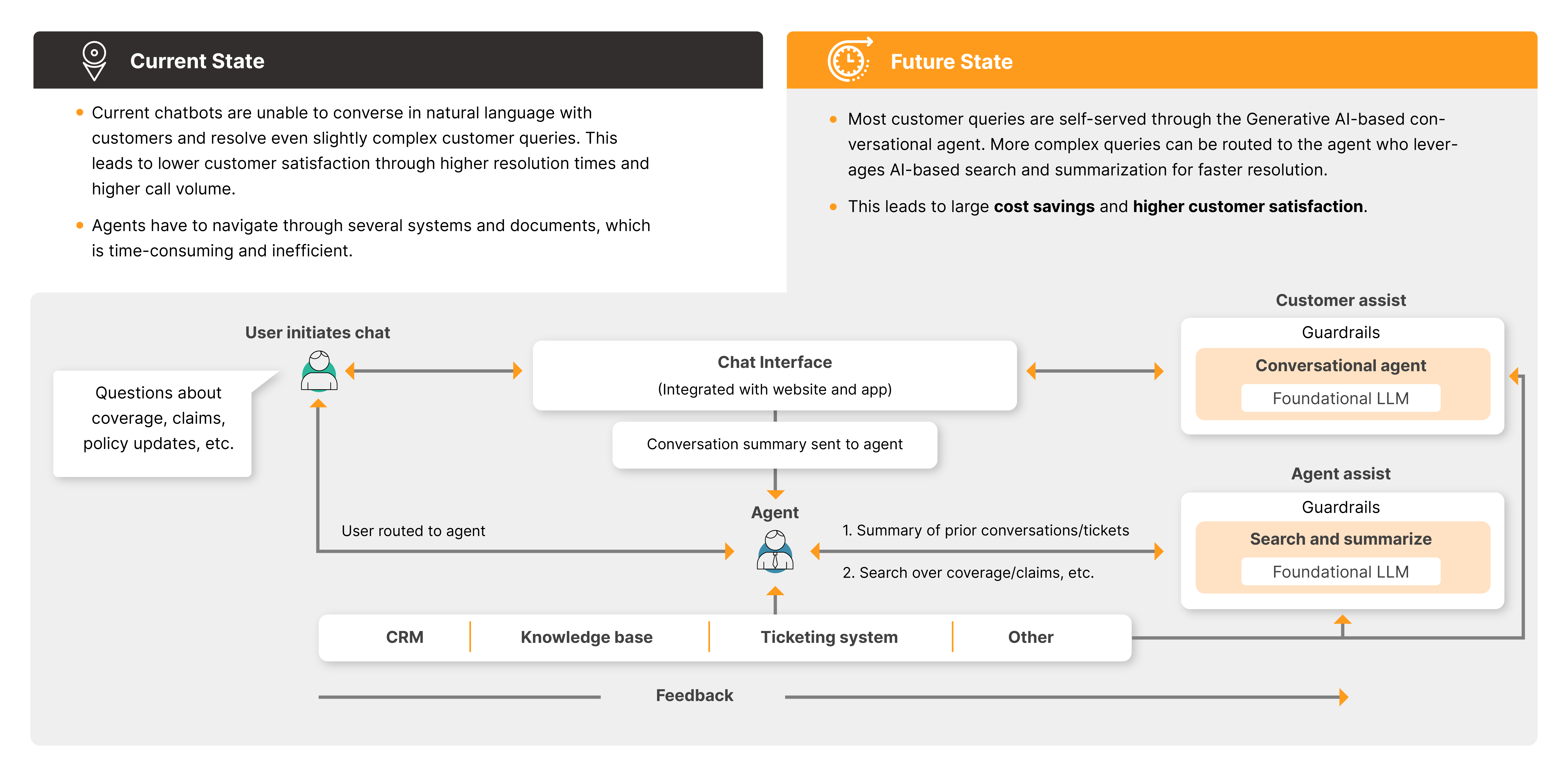
Illustration for Customer Assist Solution
Enhanced Sales and Customer Engagement with Virtual Shopping Assistant
Generative AI has the potential to personalize the customer journey across various touchpoints, creating a seamless and engaging experience. Imagine a shopper browsing through an online store, encountering suggestions that not only match their preferences but also anticipate their desires. The assistant doesn’t merely suggest; it understands, learns, and grows with the customer. By leveraging cross-category targeting and Next Best Action (NBA) strategies for existing customers, the assistant becomes a companion in the shopping adventure, guiding with insight and relevance.
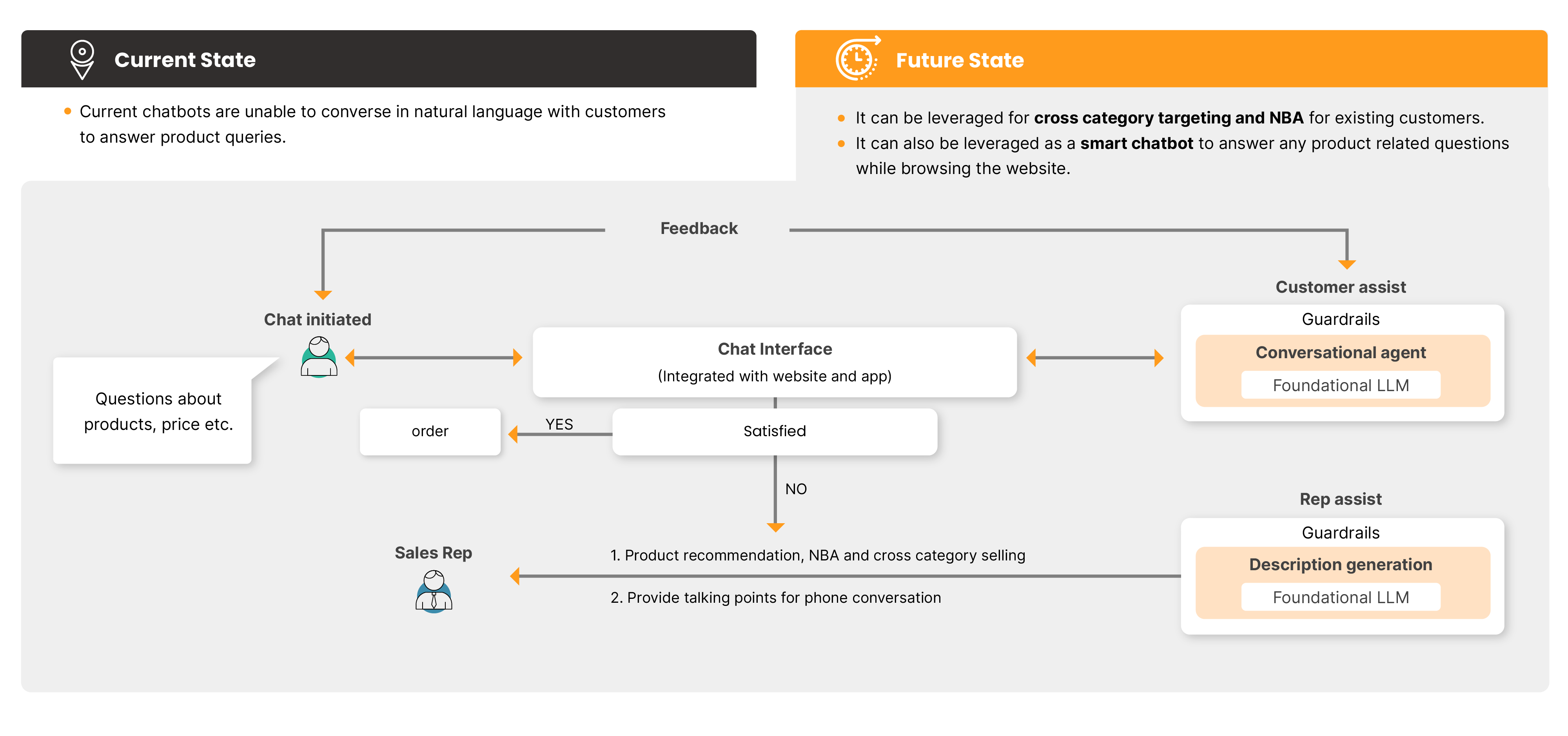
Illustration for Virtual Shopping Assistant Solution
Beyond mere navigation and suggestions, the Virtual Shopping Assistant can also be leveraged as a smart chatbot to answer any product-related questions while browsing the website. To bring this vision to life, Generative AI can be customized and fine-tuned using detailed product catalogs, customer interaction data, and behavioral insights. By incorporating human feedback and integrating it with existing systems, the Virtual Shopping Assistant can be molded to reflect the retailer’s brand, tone, and values.
Synthetic Inventory Data Generation Boosting Agility and Insight
Managing inventory data is a complex and time-consuming task for retailers, often fraught with inconsistencies and challenges in scaling. Large Language Models (LLMs) can analyze extensive inventory data, identifying trends and patterns. This allows for the creation of realistic and relevant synthetic data without revealing sensitive information, providing both privacy and comprehensive testing capabilities.
With LLMs, retailers can gain control over the data generation process, enabling augmentation and diverse scenario creation. By fine-tuning LLMs with actual inventory data and incorporating human feedback, retailers can craft a system that aligns with their unique requirements. Generative AI’s ability to produce synthetic inventory data is not just a technological advancement; it’s a strategic asset that empowers retailers to be more agile, insightful, and effective.
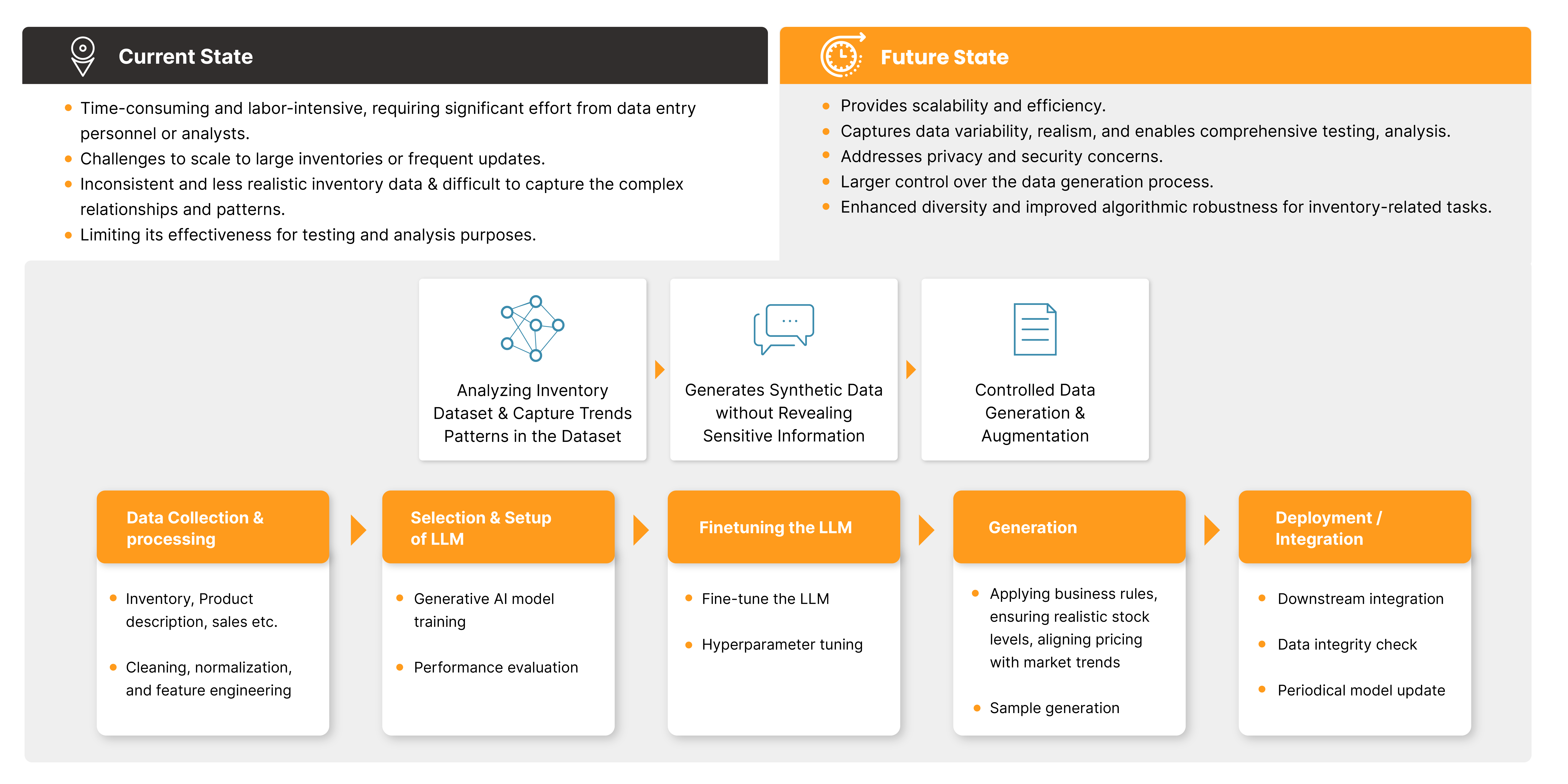
Illustration for Synthetic Inventory Data Solution
Quick and Market-Aligned Product Generation
In the realm of retail, manual product development is a time-consuming and resource-intensive process. The challenges extend from heavy reliance on manual efforts by designers and stakeholders to the uncertainty in market success due to fluctuating customer demand, competition, and trends. The future state of product generation, however, offers transformative possibilities. By automating concept creation, design exploration, and prototyping, retailers can accelerate product development. This shift towards data-driven decision-making and key metrics identification further refines design choices and mitigates market risk.
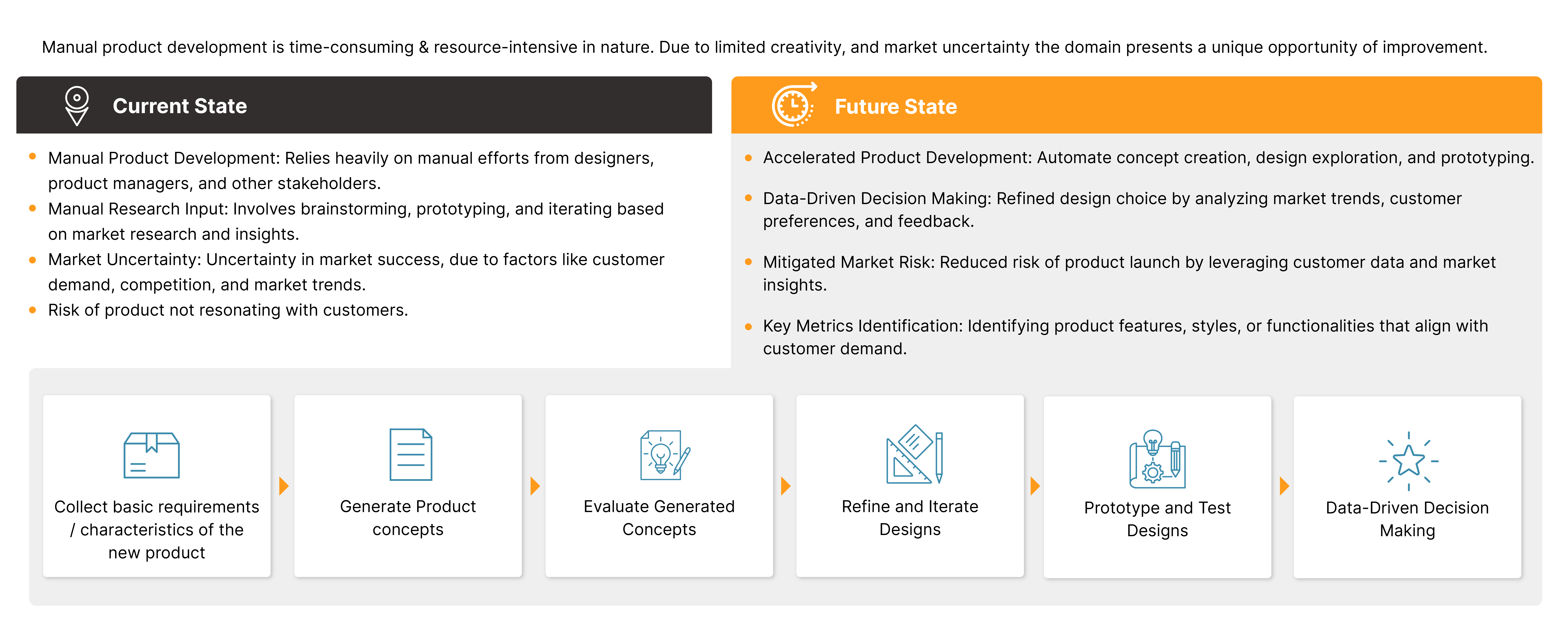
Illustration for Product Generation Solution
The journey from concept to product can be streamlined through AI-driven stages such as generating product concepts, evaluating, refining, and iterating designs, and prototyping and testing. By leveraging customer data and market insights, retailers can create products that truly resonate with their audience. The ability to fine-tune the development process with actual market insights and human feedback aligns product creation with customer demand. This empowers retailers to be more innovative, efficient, and aligned with the ever-changing market landscape.
Generating Labels with Enhanced Accuracy, Brand Consistency, and Compliance
In the current retail landscape, generating labels is a labor-intensive process, marked by time-consuming efforts from graphic designers and product managers. Limited customization, error-prone procedures, and numerous iterations not only hinder efficiency but also pose risks to accuracy and compliance. This complexity impacts both time and flexibility, making label design a challenging task.
The future, however, presents an exciting transformation. Leveraging AI for rapid iterations, customization, and consistency opens doors to significant time and resource savings. The ability to offer scalability for large catalogs, ensure accuracy, maintain brand consistency, and comply with regulations is more than an efficiency gain; it’s a strategic advantage. By automating the design process and focusing on the creative aspects of label design, retailers can elevate their brand’s identity and engage with their audience in a more meaningful way.
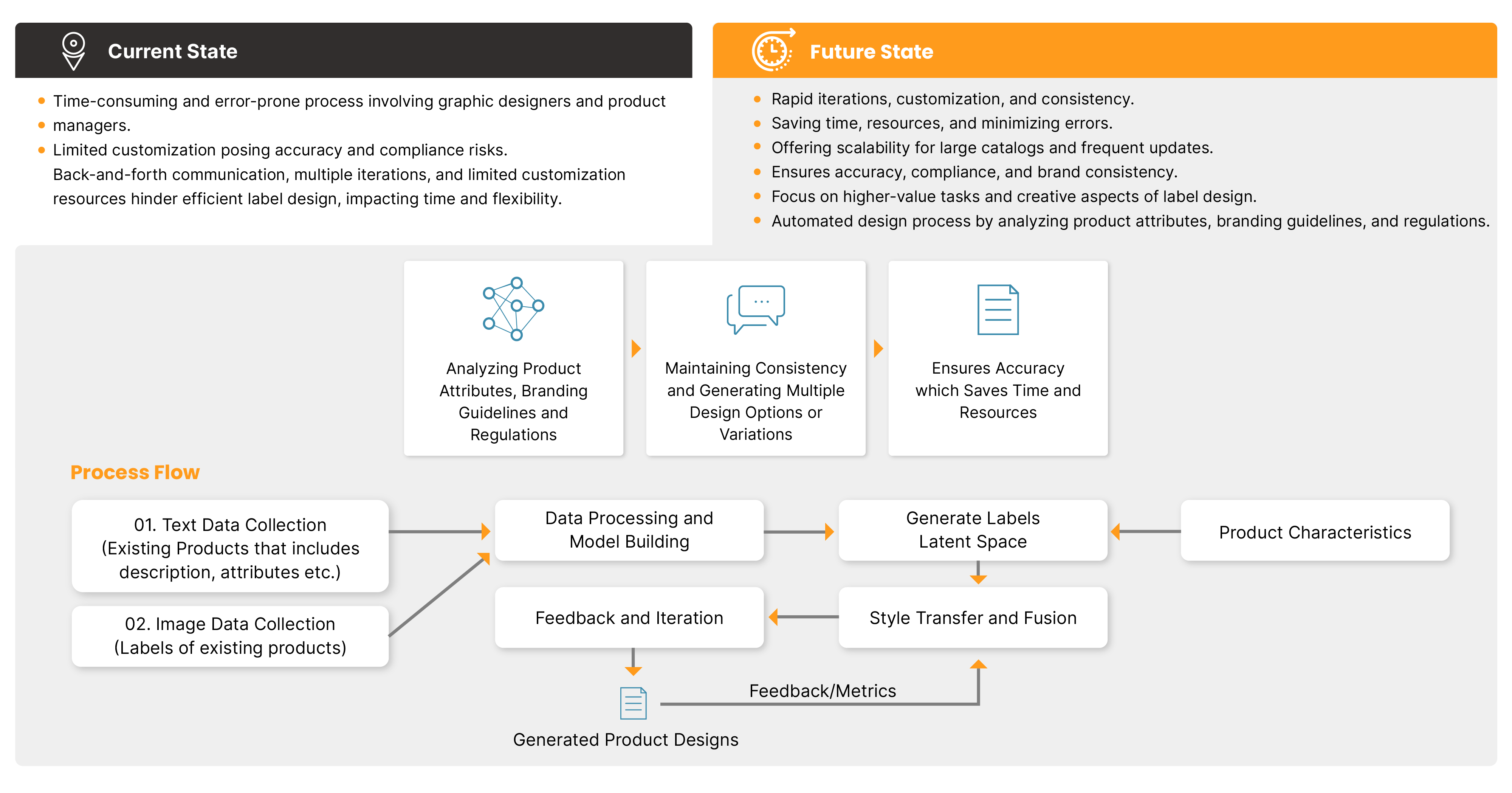
Illustration for Generating Labels Solution
Personalized Promotion for Enhanced Customer Engagement
Creating personalized promotions has traditionally been a manual, error-prone process. Manual analysis and segmentation of customer data can lead to limited insights, inefficient promotion design, and static promotions that lack relevance. The challenges in uncovering subtle customer preferences make it difficult to deliver truly personalized experiences.
The future state of personalized promotion, driven by AI, offers a transformative approach. Automated customer segmentation, real-time personalization, and adaptive promotions bring accuracy and dynamism. This shift not only improves efficiency and maximizes ROI but also ensures a seamless and cohesive customer experience throughout the shopping journey. By focusing on real-time insights and multichannel personalization, retailers can connect with customers in more meaningful ways, enhancing engagement and loyalty.
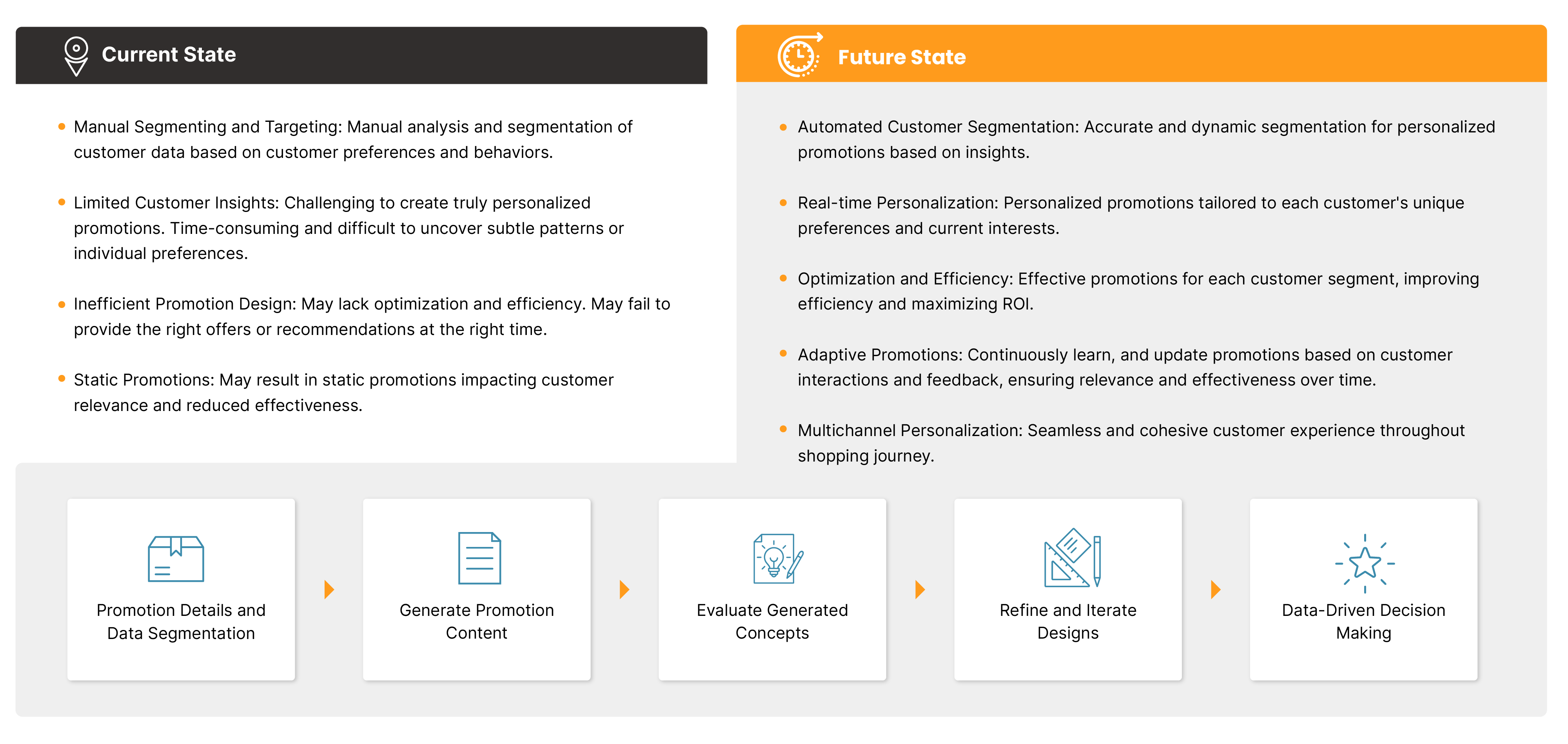
Illustration for Personalized Promotion Solution
The emergence of Generative AI in retail signals a transformative era, offering immense potential to enhance every aspect of the retail value cycle. From creating more engaging customer experiences to optimizing supply chain management, the applications are vast and varied. Retail leaders who leverage these technologies can significantly improve operational efficiencies, personalize customer interactions, and stay agile in a dynamically evolving market. By harnessing the power of Generative AI, retailers are not just adapting to current trends; they are actively shaping the future of retail, paving the way for innovative approaches and sustainable growth in an increasingly digital world. Now is a pivotal moment for industry leaders to explore and invest in these advanced capabilities, ensuring they remain at the forefront of retail innovation and excellence.





